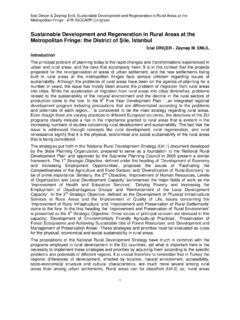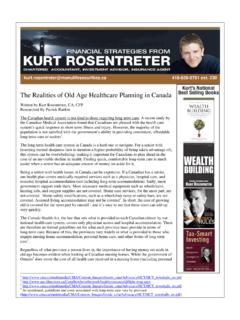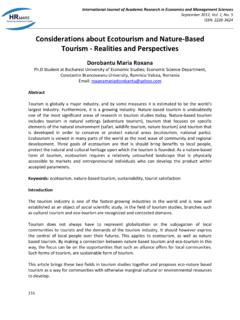Transcription of REGIONAL DEVELOPMENT PLANNING - ISSUES …
1 Ijaz Ahmad & Prof. Dr. Ihsan Ullah Bajwa REGIONAL DEVELOPMENT PLANNING ; ISSUES and realities 41st ISoCaRP Congress 2005 1 REGIONAL DEVELOPMENT PLANNING - ISSUES AND realities Introduction The urban population in the Asian and Pacific region between 1991 and 2020 is expected to rise from 991 million to billion. This means an additional billion people will be living in the urban centers of Asia. Cities already feel this increase tangibly, as they strain to properly service the physical and social needs of their populations.
2 The urban poor feel the pinch as they struggle to feed, clothe and house themselves and to improvise other basic services and amenities like water supply and sanitation. This lack of adequate shelter and services is one of the most pressing challenges confronting most Asian cities on the threshold of the 21st century (HABITAT, 1994) . This haphazard population growth is exerting a huge pressure on the available existing facilities present in the urban as well as small towns. On the other hand developing countries are making policies in order to solve the problems caused by this rapid population growth.
3 Case after case illustrates the fallacy of DEVELOPMENT policies relying on short-run economic efficiency of projects productive primarily (or even uniquely) in terms of their contributions to national growth. There is conclusive evidence in many places that such policies create dangerous chronic imbalances between town and country; and more often than not they cause distortions and internal inconsistencies in the structure and pace of DEVELOPMENT . But most importantly, such short range DEVELOPMENT strategies generally fall to create sufficient internal markets for the very industries they promote; and while a relatively small segment of a nation derives direct (or indirect) benefit from such productive investments, by far the larger part of the nation goes on subsisting outside the mainstream of DEVELOPMENT .
4 The more common among these imbalances and inconsistencies are: i. A critical lag in the developing countries, between the art of economic growth and employment and the rate of population growth; ii. A slow range of investment (in the developing countries) in social programs as compared with investments in their economic programs; iii. A growing gap between the fast rate at which the redundant and underemployed grow in numbers, and the agonizingly slow rate at which industry can offer new employment; and iv.
5 A rapid deterioration of the quality of life in most metropolitan agglomerations, while economic productivity and social investment rise at unprecedented rates. The current world trend towards urbanization is a direct consequence of the steadily building pressure on a land that could offer but mere subsistence already to generations before the present agricultural revolution. But the great concentration of activities and people in major cities and metropolitan belts, and the resulting acute worldwide urban crises, are mainly due to the still prevailing traditions of locating new economic and other DEVELOPMENT activities, primarily on a project by project basis, considering short-run economic benefits rather than the long range benefit/cost ratios of broader sectoral, REGIONAL or national DEVELOPMENT plans.
6 Essentially economic considerations often lead to an excessive concentration of the requirements of the world market in preference to a nation s own needs, so much so that the urbanization pattern in a given developing country may well be a direct result of the demand for certain primary goods in a group of highly industrialized countries. Also, when external investment is sought, the already considerable limitations imposed by the concept of economic efficiency are compounded Ijaz Ahmad & Prof.
7 Dr. Ihsan Ullah Bajwa REGIONAL DEVELOPMENT PLANNING ; ISSUES and realities 41st ISoCaRP Congress 2005 2with political and ideological ISSUES . This then, restricts even further the prospects of using the world s accrued technical, capital and human resources for the establishment of a viable economy in a tranquil world, which in turn would enable the pre-industrial nations to use their own natural wealth and human capabilities for their own benefit. DEVELOPMENT PLANNING ; A Tool to Solve Problems Jenessen (1992) says that PLANNING is concerned with where to go.
8 However, where we are and where we have been; are questions of low interests for most planners. The former task is intellectually stimulating and has captured the attention of planners and politicians. John Stephenson (1982) points out that ' PLANNING falls broadly into two categories. First, DEVELOPMENT PLANNING is the part of the process in which the future of the area in question is mapped out. The plans will be concerned not only with building but also with job opportunities, manpower, education, and transport.
9 Secondly, DEVELOPMENT control ensures that the construction of buildings and the use to which land and buildings are put conforms to established policies. It additionally serves various other purposes, such as ensuring that the surroundings are not unnecessarily spoilt and that public services such as water and sewage are not overloaded'. John Ratcliffe (1985) says that town PLANNING is 'concerned with providing the right site, at the right time, in the right place, for the right people'.
10 Lewis Keeble (1969) defines Town PLANNING as 'the art and science of ordering the use of land and siting of buildings and communication routes so as to secure maximum practicable degree of economy, convenience and beauty'. What is DEVELOPMENT ? DEVELOPMENT may be defined as 'the carrying out of building, engineering, mining or other operations in, on, over or under land, or the making of any material change in the use of buildings or other land' (Cullingworth, 1988). DEVELOPMENT may include all types of buildings, completely new construction, demolition and reconstruction or addition & alteration, whether they are residential, commercial, and industrial or others, they come under the definition of DEVELOPMENT .









